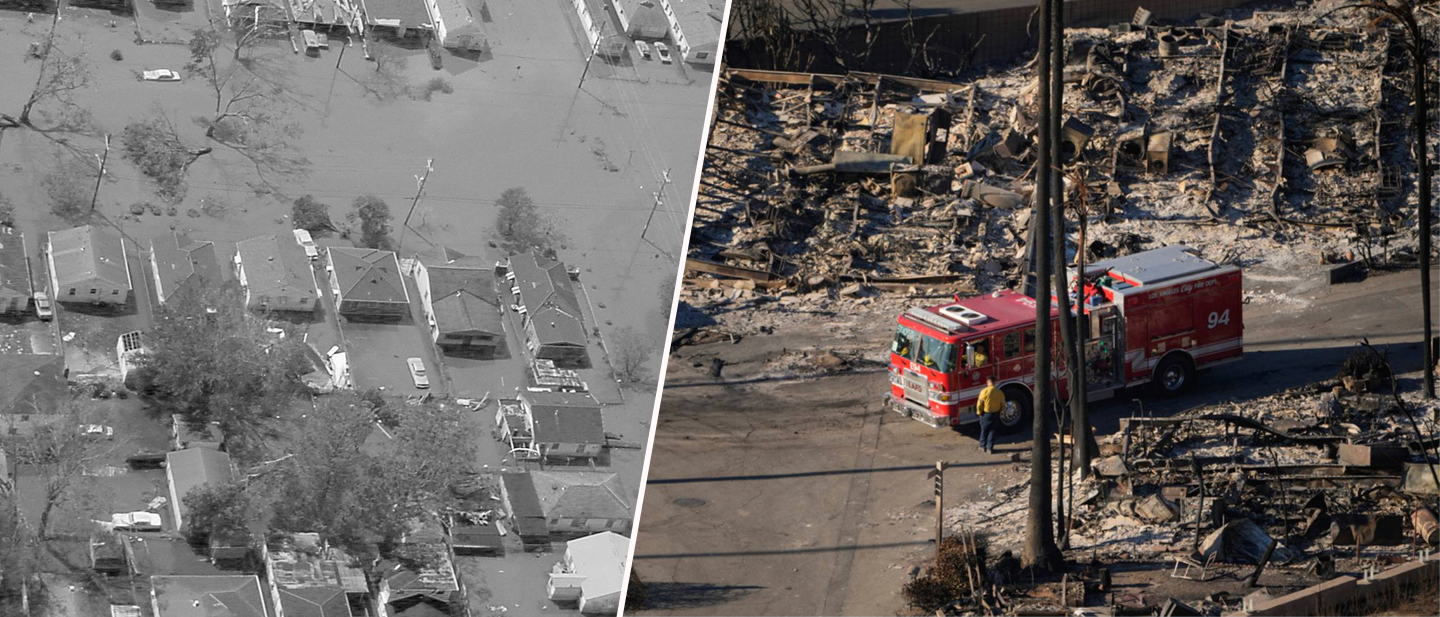DANIEL’S TAKE
Back to the Future: Lessons We Should Learn from Katrina in Rebuilding California

Back to the Future: Lessons We Should Learn from Katrina in Rebuilding California
The year 2025 marks two decades since Hurricane Katrina devastated New Orleans and the Gulf Coast, a disaster that laid bare the stark inequities in disaster response and recovery. At the time, the world watched in disbelief as the storm disproportionately affected low-income and Black communities, exposing systemic failures that compounded the tragedy. Now, California finds itself grappling with the catastrophic wildfires that have ravaged the state, with thousands of acres burned, lives lost, and communities displaced. Among these, the Eaton Fire has decimated areas like Altadena, including its historically Black and minority neighborhoods. Yet, the scope of this disaster reaches far beyond one community, challenging all Californians to confront the realities of a changing climate and the societal inequities it exacerbates.
As a non-resident of California, I acknowledge that rebuilding after the devastating fires requires a nuanced understanding of the state’s unique challenges. However, it is important to recognize that some systemic issues remain unaddressed by California’s leadership. The governor and mayor have yet to reconsider California’s flawed forest management policies, which many experts believe exacerbate wildfire risks. Moreover, there is no concrete plan to secure fire insurance for homeowners in other at-risk areas, leaving countless families vulnerable. Additionally, the threat of any insufficient funds or even bankruptcy of the state’s insurance program poses cascading challenges that demand immediate and strategic action to prevent further instability for Californians. California law requires insurance companies to hold reserves adequate to pay out claims even in a catastrophe such as these fires, but the scale of this disaster raises critical questions about the system’s ability to weather such unprecedented pressures.
The fires raging across California are among the most destructive in the state’s history, leaving a trail of devastation that includes iconic landmarks, middle-class neighborhoods, and historically underserved communities. The sight of celebrity mansions reduced to ashes may dominate the headlines, but a deeper examination reveals a broader and more troubling narrative. Communities across socioeconomic and racial lines have been impacted, and the question of how to rebuild—and for whom—looms large.
Altadena serves as a microcosm of the broader challenges facing California. The L.A. County wildfires have left the diverse and historic Altadena in ashes and rubble. Families of color, making up over half of Altadena, have bought homes and kept them for generations. The Black homeownership rate exceeds 80%, almost double the national rate. You see, until the 1960s, Altadena was almost an entirely white community largely because of redlining, the practice of discriminating against people in certain areas by denying them access to financial support, like mortgages. People of color and other underrepresented communities weren’t able to buy homes in Pasadena or parts of Altadena because of this practice. Major societal change came during the Civil Rights Era. Racist property-use laws became unenforceable and later legal actions banned housing discrimination outright, helping end de facto practices that locked Black families out. Lastly, Altadena, an unincorporated town in the foothills of the San Gabriel Mountains, was a soulful middle-class suburb drawing diverse groups and creatives unlike anywhere else in Los Angeles County. People of color are more than half of Altadena’s population, with Latinos making up 27% and Black Americans 18%. Though it has diversified over the decades, the town’s population has remained steady at around 42,000. To many, it represents California’s diversity and the future of America. This community’s resilience and diversity have been its hallmarks, but the Eaton Fire has placed its future in jeopardy. Countless families now face the daunting prospect of rebuilding amidst skyrocketing costs and the pressures of gentrification, a fate that mirrors the post-Katrina displacement of New Orleans’ low-income residents.
Hurricane Katrina’s aftermath offers sobering lessons for California’s recovery. After the storm, New Orleans became a case study in “climate gentrification,” where redevelopment projects prioritized profit over people, forcing many residents to relocate permanently. Cultural and economic diversity—once defining features of the city—were eroded as wealthier newcomers took advantage of redevelopment opportunities. The parallels to California’s current crisis are undeniable. Without intentional policies and community-driven recovery efforts, the fires risk accelerating a similar displacement dynamic across the state.
It is essential to recognize that these wildfires are not isolated events. They are part of a broader pattern of climate-driven disasters that disproportionately affect low-income and minority communities. Climate change is no longer a distant threat; it is a present and growing reality that reshapes lives and landscapes. Fires in California, hurricanes on the Gulf Coast, and rising sea levels are all symptoms of a warming planet, and their human costs are steepest for those with the least resources to recover.
The lessons of Hurricane Katrina underscore the importance of a coordinated, equitable, and compassionate approach to disaster recovery. The Bush Administration’s post-Katrina review identified 17 major challenges, ranging from national preparedness to housing and public health. Addressing these systemic shortcomings is critical for California as it navigates its own recovery. Federal, state, and local governments must act with urgency and unity to meet the scale of this crisis.
The incoming Trump-Vance Administration now has an opportunity to rise above past partisan politics and lead with dignity, compassion, and equity. History has shown us the devastating consequences of politicizing disaster relief. During Hurricane Maria in 2017, federal disaster aid to Puerto Rico was delayed by nearly $20 billion, exacerbating the island’s suffering. In California, where wildfires have burned nearly 40,000 acres and caused an estimated $250 to $275 billion in damages, federal aid is not just a lifeline—it is a moral obligation.
President-elect Trump’s campaign rhetoric and threats to withhold federal aid from California underscore the precariousness of the moment. In context, the federal government typically covers 75% of rebuilding costs after a major disaster, funding critical infrastructure like roads, water systems, and fire stations, as well as temporary housing and home-rebuilding assistance for displaced families. Yet Trump’s feud with California Governor Gavin Newsom raises concerns about whether this support will be provided in full and in a timely manner. Any delay or denial of federal aid would not only deepen the suffering of displaced Californians but also set a dangerous precedent of using disaster relief as a political weapon.
Newsom has already taken Trump’s threats seriously, drafting contingency plans for a state-funded emergency response should federal aid be withheld. But no state, no matter how resourceful, can fully shoulder the financial burden of recovery alone. Federal disaster funds are essential to rebuilding the lives of the nearly 12,000 families who have lost their homes and the countless communities that must reconstruct vital infrastructure. To withhold this aid would be an unforgivable act of retribution against millions of Americans in their hour of greatest need.
The Trump-Vance Administration faces a defining moment—a chance to rise above petty political grievances and demonstrate that leadership is about serving people in their darkest hour. Families displaced by the fires cannot afford delays, and the state cannot rebuild without the swift allocation of federal resources. Threatening to withhold aid from California during a time of unprecedented devastation is more than political posturing; it’s an abdication of responsibility to millions of Americans.
This administration must act with urgency and compassion. Federal aid must flow swiftly to fund temporary housing, rebuild essential infrastructure, get our children back in school, and provide relief for the 12,000 families who have lost everything. Californians, regardless of political affiliation, deserve a recovery effort that prioritizes their lives and livelihoods over partisan agendas. Any attempt to use this crisis as a tool for political retribution would deepen divisions and betray the fundamental purpose of government—to protect and uplift its people.
The question now is whether the Trump-Vance Administration will meet this challenge with the moral clarity and decisive action required to rebuild not just homes and communities, but trust in the federal government’s ability to stand united in times of great need. The stakes are too high for anything less.
